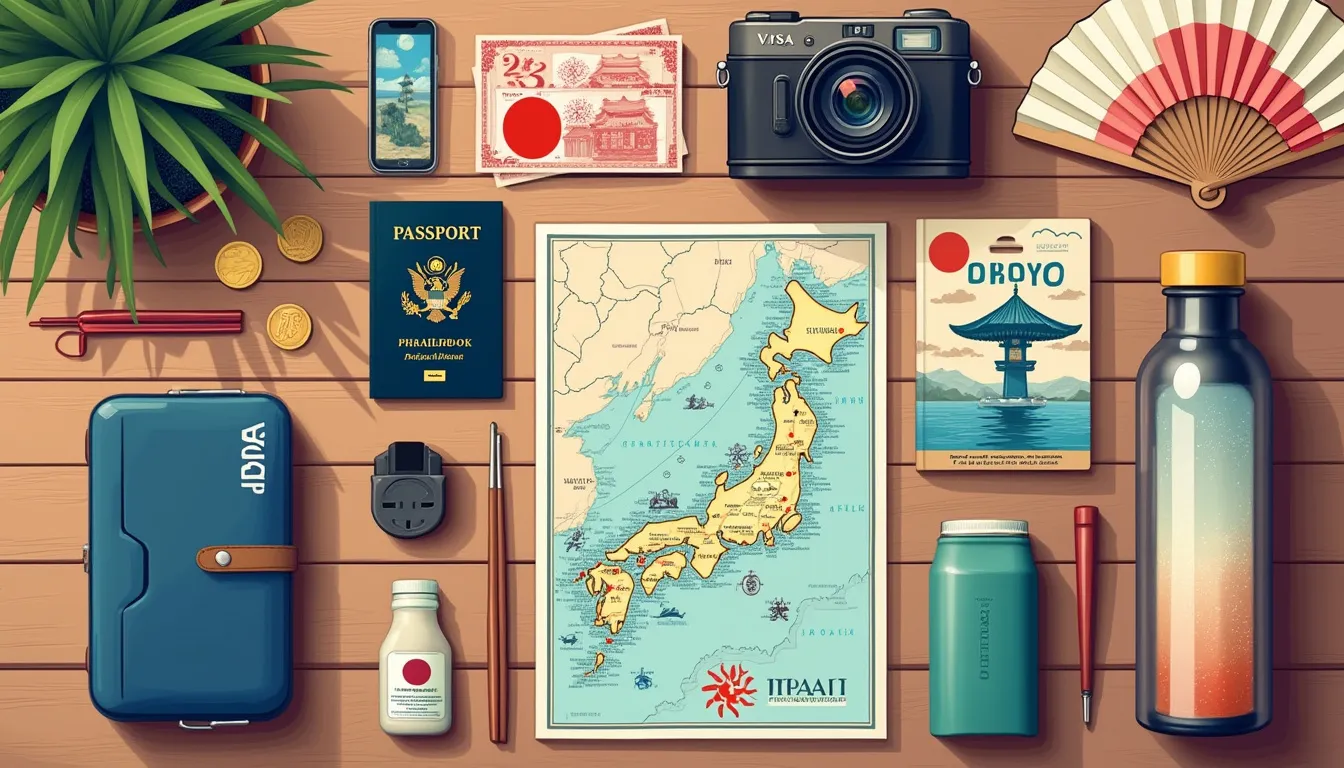Planning a trip to Japan offers a unique opportunity to explore a culture rich in history, cuisine, and technological innovation. To make the most of your journey, it is essential to pack wisely and be well-prepared for the diverse experiences awaiting you. This comprehensive guide on what to bring when traveling to Japan will ensure you’re equipped with all the necessary items to fully enjoy your trip. From understanding the seasonal clothing needs dictated by Japan’s varying climate to selecting the right footwear for day-long explorations of its vibrant cities and serene cultural sites, you’ll find detailed advice to keep you comfortable and fashionable. In today’s digital age, traveling without the right electronic accessories can be inconvenient—consider essential travel gadgets, such as adapters and portable Wi-Fi devices, that ensure your electronic devices remain charged and connected throughout your journey. Additionally, communication is key; translation apps are invaluable tools for overcoming language barriers. Understand Japan’s cultural nuances with thoughtful packing tips, like bringing small gifts that respect local customs or preparing with guidebooks for seamless navigation both in bustling urban areas and tranquil rural settings. Being conscious of hygiene essentials, including items like masks and sanitizers, is also crucial for your health and safety. By meticulously planning what to bring when traveling to Japan, you can immerse yourself in the country’s enchanting traditions and contemporary marvels with ease and confidence.
Packing List for Japan: Must-Have Essentials
Clothing and Footwear Considerations
Seasonal Clothing Recommendations Based on Japan’s Climate
When considering what to bring when traveling to Japan, it’s essential to understand the country’s distinct seasons. Japan experiences four pronounced seasons, each requiring a specific wardrobe to ensure comfort and adaptability during your travels.
Spring (March to May): The arrival of cherry blossoms signals the need for light layers. Pack a combination of long-sleeved shirts, light sweaters, and a medium-weight jacket. Temperatures can vary, particularly in March, so a versatile outfit allows you to adapt to cool mornings and warmer afternoons.
Summer (June to August): Summers in Japan can be hot and humid, with temperatures soaring above 30°C (86°F). Light, breathable fabrics like cotton are advisable, along with items like t-shirts, shorts, and sundresses. However, keep in mind the cultural norm of modesty; opt for knee-length skirts or shorts. A sunhat and sunglasses are also advisable to protect against the intense sun.
Autumn (September to November): Known for its cool breeze and vibrant foliage, autumn requires a mix of light to medium-weight clothing. Consider packing long pants and light jackets. A scarf may also be beneficial as temperatures begin to dip in the evenings, especially in November.
Winter (December to February): Winters can be chilly, especially in northern regions and mountainous areas. Essential items include a heavy coat, thermal wear, gloves, and a warm hat. Layering is key, as indoor heating can make interiors quite warm, requiring you to adjust your attire accordingly once indoors.
Comfortable Walking Shoes for Exploring Cities and Cultural Sites
Japan’s cities are known for their extensive networks of public transportation, bustling streets, and numerous cultural landmarks, each best explored on foot. Thus, when determining what to bring when traveling to Japan, prioritize comfortable walking shoes. These shoes not only need to be apt for walking long distances but should also consider style and functionality given the frequent need to remove footwear upon entering homes, temples, and some restaurants.
Choose versatile footwear such as sturdy sneakers or lightweight hiking shoes for urban exploration and cultural site visits. Opt for shoes with good arch support and cushioning to navigate the cobbled streets of historical areas and the expansive paths of shrines and gardens comfortably. Extra consideration should be given to shoes that are easy to slip on and off to adhere to the country’s customs concerning footwear in certain settings.
If your itinerary includes visits to Japan’s picturesque rural areas or hikes within national parks—such as Mount Fuji or the trails of the Japanese Alps—a pair of waterproof hiking boots would greatly serve your needs. These should support various terrain and withstand unpredictable weather conditions.

II. Personal and Cultural Essentials for Your Japan Trip
A. Hygiene and Personal Care Items
When considering what to bring when traveling to Japan, it’s crucial to think about your hygiene and personal care needs. While Japan offers a wide array of personal care items, not everything you use regularly might be readily available or easy to find. Here are a few essentials to pack to ensure you stay comfortable throughout your trip:
1. Toiletries That Might Not Be Readily Available in Japan
Toiletries are often specific to personal preferences, and while Japan has excellent pharmacies and convenience stores, some items are worth bringing from home. For instance, if you rely on a specific brand of toiletry or if your hair and skin products cater to particular needs (like curly hair products or hypoallergenic lotions), it’s best to pack enough for your entire stay. Additionally, deodorant options in Japan may differ from those in Western countries, so bring your preferred brand to avoid any surprises.
If you wear makeup, especially foundation or concealer, matching your skin tone might be challenging in Japan due to limited shade ranges. Ensure you bring your favorite cosmetics to avoid inconvenience. Also, if you’re used to specific personal hygiene products, such as tampons, consider bringing your supply, as these items might not be easily found in some areas.
2. Health and Safety Essentials, Including Masks and Sanitizers
Health and safety are paramount, especially in today’s travel climate. Masks are widely used in Japan, not just for health reasons but as a cultural practice to minimize the spread of illness. It’s advisable to pack a supply of high-quality masks, especially if you have a preference for specific types or brands.
Hand sanitizers are another essential item to pack. While they are available in Japan, having your own ensures you’re always prepared. Choose travel-sized bottles to comply with airport security rules and opt for sanitizers with at least 60% alcohol content for effective results.
Furthermore, don’t forget to bring a basic first-aid kit with items like band-aids, antiseptic wipes, and any prescription medications you might need. Although pharmacies in Japan are well-stocked, having your personal emergency kit ensures you have the right items quickly to hand. Also, consider packing motion sickness medicine if you’re planning on traveling by train or bus through the hilly or coastal areas of Japan.
B. Navigating Japanese Culture: Practical Items to Pack
1. Gifts or Souvenirs Respecting Japanese Customs
Gift-giving is an integral aspect of Japanese culture, reflecting thoughtfulness and gratitude. When visiting friends, staying with a host, or even as a gesture of appreciation to a guide, having a small gift is a considerate practice. Items like local specialties from your home country, small packaged sweets, or souvenirs can make well-appreciated gifts. Ensure the gifts are neatly wrapped, as presentation is essential in Japan.
2. Pocket Guidebooks and Maps for Easier Navigation in Urban and Rural Areas
Japan’s public transport is world-renowned for its efficiency, but navigating its myriad of train lines and bus routes can seem daunting to first-time visitors. Although smartphone apps are invaluable, having offline alternatives is also wise. Pocket guidebooks with maps are an excellent resource, providing insights into regional highlights and helping you navigate when digital resources are unavailable. Maps can be found in stations and travel centers, but a personal guidebook in your language ensures you have access to maps and tips at all times.
Even in cities as large and bustling as Tokyo, English signage can be limited, particularly in restaurants and rural areas. A good guidebook that offers translations and points of interest can enhance your travel experience by providing valuable cultural context and helping you discover places off the beaten path. Be sure to choose guidebooks that are up-to-date with recommendations on local eateries, cultural etiquette, and current events, ensuring a smoother travel experience.
In conclusion, knowing what to bring when traveling to Japan is crucial for a smooth and enjoyable journey. By carefully considering the climate, travelers can ensure they are equipped with the appropriate seasonal clothing and comfortable footwear necessary for navigating both urban landscapes and serene cultural sites. Staying connected and overcoming language barriers is made simpler with the inclusion of travel accessories such as electronics adapters, portable Wi-Fi devices, and translation apps. Moreover, packing personal hygiene items and health essentials like masks and hand sanitizers safeguards travelers’ well-being, especially when products might not be easily accessible. Understanding and respecting Japanese culture is enhanced through thoughtful preparation, such as bringing small gifts that honor local customs and having pocket guides to assist in traversing various regions of Japan. By adhering to these packing recommendations, travelers can enhance their overall experience, ensuring both convenience and cultural respect during their visit to this fascinating country.







